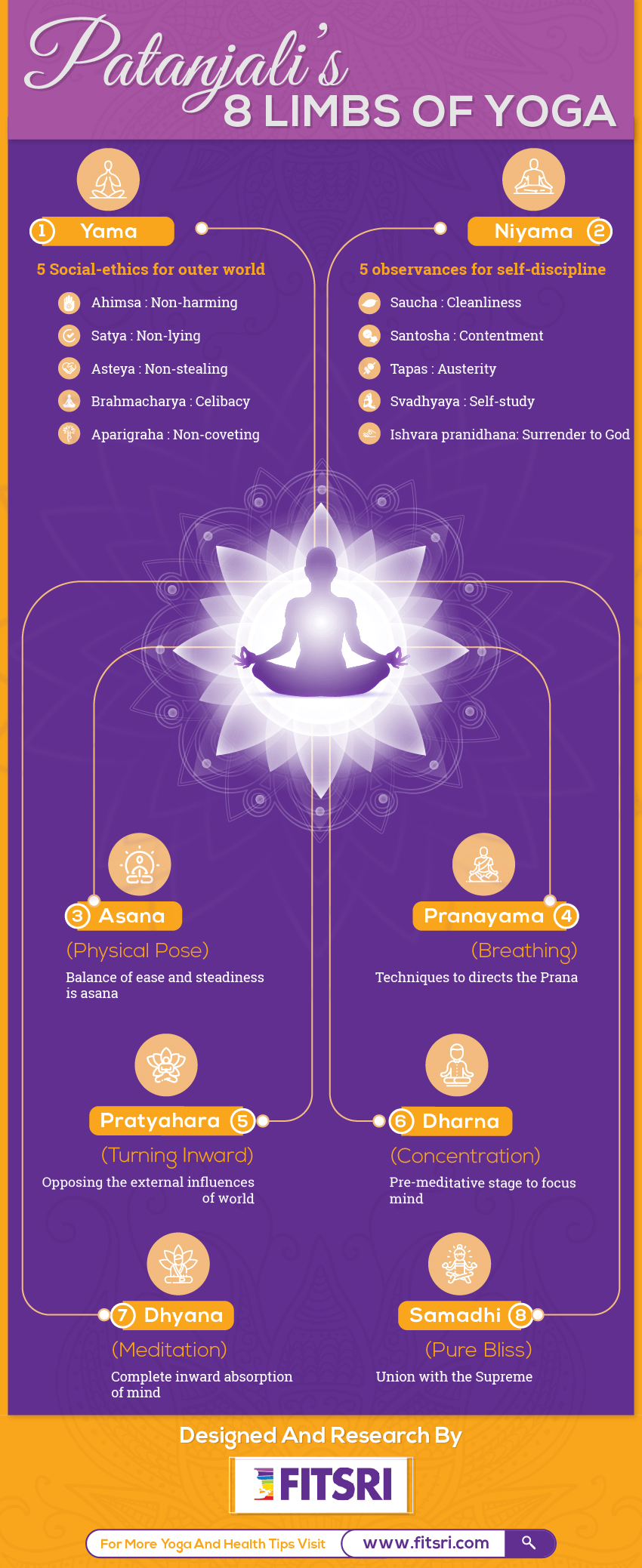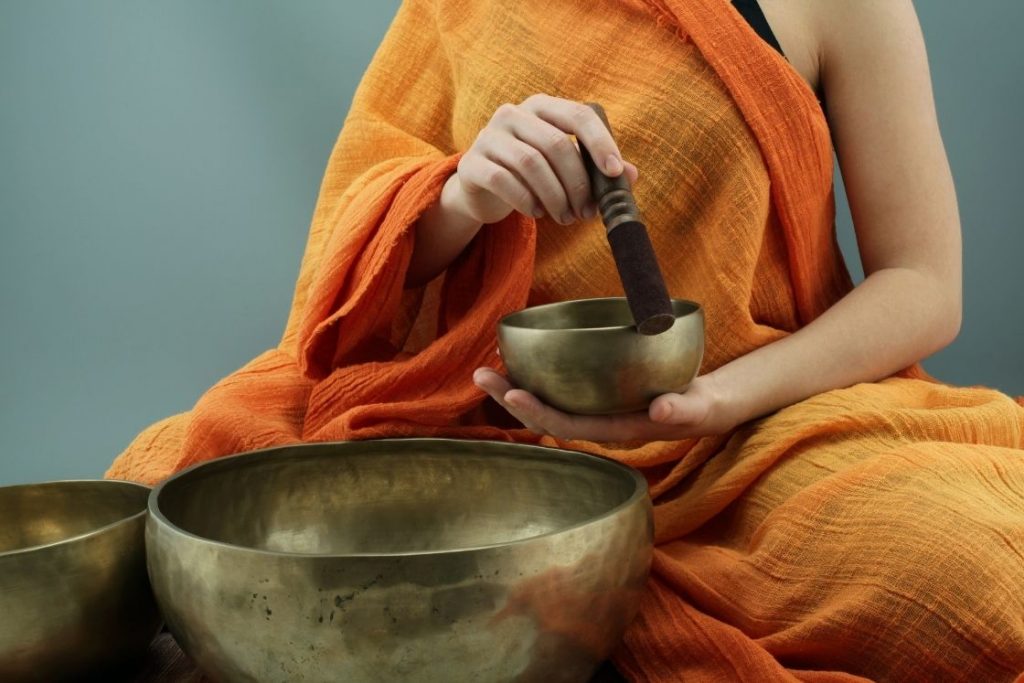
Imagine yourself admiring a very beautiful waterfall. You are observing every little detail of the flowing water, its color, solid white froth, heart-stimulating sound as it is rushing towards the ground, gathering each feature in your mind as you adore its presence.
Here, you are so concentrated on admiring these aspects of a gorgeous waterfall that you forget your surroundings. You are just so lost in the waterfall that you feel disconnected from your material conditions or physical awareness.
This is exactly the state of Dhyana – a stage of deeper concentration where your awareness is only flowing towards the one object of perception. You have absolutely engrossed in your current state that the outer reality is untrue. What exists is only that pure awareness flow between you and the beautiful waterfall.
What is Dhyana?
The word Dhyana is generally translated as meditation. Often it is used to mean concentration or focus. But the meaning of the word lies in the deeper concepts. In Sanskrit, Dhyana is broken down as dhi, meaning mind and yana, meaning flowing or moving.
Hence, one explanation of the word Dhyana can come as ‘the uninterrupted flowing state of mind’. Here, flow is towards the object or idea of meditation. The Dhyana state, thus, is a state of uninterrupted flow in connection with the object that a person is meditating upon.
As the word flow itself characterizes continuity and steadiness, so does the state of Dhyana. The person is absorbed in the connection that he forms with the object of meditation and loses his sensory feel.
One more way to explain Dhyana comes from the root word ‘Dhyayi’, which means ‘to think of’. In this sense, Dhyana is the state of mind that requires deep mental thinking or concentration. However, we must keep in mind that this level of mental depth can only be attained through intense elemental practices.
The 7th limb of yoga

Maharshi Patanjali describes Dhyana is the seventh limb of Yoga. It’s the second last stage of reaching Samadhi; the highest state of yoga. The first six limbs act as the essential practice that cultivates awareness in order to achieve the state of Dhyana.
In short, Dhyana cannot be reached as a stand-alone exercise. It can only come when it is backed by the deep practice of the preceding 6 limbs.
- Yamas – The first limb is the practice of 5 social disciplines to develop a positive attitude towards things in our surroundings.
- Niyamas – The second limb is the practice of 5 personal disciplines.
- Asana – The third limb is the practice of cultivating awareness of the body.
- Pranayama – The fourth limb is the practice of partially controlling the mind via breath.
- Pratyahara – The fifth limb is the practice of inwarding the awareness to focus on inner-self.
- Dharana – The sixth limb is the exercise to develop concentration.
Observe how each preceding limb is directing us one step closer to Dhyana.
Dhyana according to Patanjali
The Yogasutras describe Dhyana as, “Tatra Pratyaya Ekatanata Dhyanam” means where there is a base of continuous, uninterrupted contemplation, is the stage of Dhyana. ‘There’ is indicated as a place, object, or idea of meditation.
It can thus be elaborated as a continuous flow of the mind toward the object of meditation. As a result of this flow, a connection forms between the meditator and the object of meditation.
When this uninterrupted link is formed between the both, the meditator loses his touch with the sensory aspects. The only active part that remains is his mind. And the mental activity that occurs in the meditator’s mind is only in connection to the object he is meditating on.
Dhyana builds up when a meditator progresses in the previous stages of Yoga. After regulating the body, breath, senses, and practising concentration, he reaches a state of deeper levels of meditation where he is connected to the object and nothing else.
In this state, the meditator is absolutely immersed in the process of meditation itself that he cannot see himself and the object separately.
The Flow from Dharana to Dhyana

The transition from Dharana to Dhyana is very subtle but it acts as an important shift in perspective and practice.
Dharana is the act of focusing on an object, idea or thought; it’s called active focusing where we put mental effort to keep our attention unscattered. We can’t keep focus unscattered for a longer duration when there is effort working in the process.
When we are able to hold the mind for a longer duration, or Dharana is maintained for a longer time, in a continuous manner without any interruption, that state of mind is called Dhyana.
We must understand this, Dharana is the act of focusing and Dhyana is a state of mind which we discover by consistent concentration practice.
When you are asked to focus on your breath, you struggle with a lot many things. You can feel cold or your mind might wander. You have to bring the mind back to focusing on one point that is your breath. This is the Dharana stage, where your mind is on single-pointed attention.
When this attention is established without any distraction, the meditator transits to the Dhyana stage. He experiences Dhyana when the mind wanders nowhere or is disturbed by nothing and a continual flow is established between the object and himself.
In Dhyana, the person loses all his attachments and breaks his connections with the sensory world of past and present. In all the previous meditative stages like Dharana, the person seems to transcend himself to higher and higher stages and seem lifeless. Whereas in Dhyana, the person is said to be aware of, not his senses, but only his current state of being.
How to Practice Dhyana?
One factor we must keep in mind is that Dhyana is the seventh limb of Ashtanga Yoga and for the same, a person seeking enlightenment through Yoga is required to have accomplished the previous stages.
The stage of Dhyana can be achieved when the person is performing all the Yamas, Niyamas, doing regular practice of Asanas, Pranayama, and Pratyahara.
Here are some ways you can practice Dhyana;
1. Observe your Breath
Focusing on your breathing is the key factor to practice Dhyana. Breathing exercise is the essential practice that you have to perform if you wish to achieve steadiness of the body and calmness of the mind. Observing the breath means to deep breathe while concentrating your mind solely on your inhalation and exhalation.
For dhyana yoga, you can do slow and deep yoga breathing exercises like alternate-nostril breathing (Anulom-Vilom) and Bhramari Pranayama. When doing these pranayamas, firstly connect with the natural cycles of your breath and bring your awareness to it. Then slowly shift the breathing pattern to specific pranayama.
2. Practice Vairagya (detachment)
Dhyana is said to be the practice of Vairagya (detachment). When the person sits for Dhyana, he is required to feel detached from not just his senses but also his memories and belongingness.
Performing trataka or flame-gazing exercise is a good way if you want to delve into the Dhyana. It reflects the person’s transition from Dharana to Dhyana. Deep gazing at the flame develops intense concentration and acts as a foundation for Dhyana.
The benefits of these exercises are that they will help you gain control over your restless and thoughtful mind. They will also support you in bringing your focus to one place and form a connection with that one place. As a result, you find yourself more balanced, both physically and mentally.
3. Maintain Steady Physical Postures
You have to stay steady or hold your meditative posture for a long time when you are performing Dhyana. The meditative postures require stillness as also explained by Patanjali as Sthiram Sukham Aasanam. It means one has to maintain steadiness to get the best benefits out of the postures. This comes when you practice the Asana stage honestly.
Performing different asanas, especially the balancing asanas like Vrikshasana (tree pose), Utkatasana (chair pose), Tadasana (mountain pose) and meditative postures like Padmasana (lotus pose), Ardhapadmasana (half lotus pose), Vajrasana (thunderbolt pose) will enhance your steadiness.
The practices of body and mind stillness as reflected in Asana and Pranayama stage ensure your steadiness in the stage of Dhyana.
4. Practice Stillness
Dhyana is the deepest level of meditation where you are aware of only your state of being. To experience such a consciousness requires incredible stillness. Thus, it is important to sit still, close your eyes, and contemplate on your yogic journey.
Pranayama aids you in this. Also, to stay still, it is important to withdraw from the senses and turn your attention inward. Hence, Pratyahara is necessary.
5. Patience and Practice
The state of Dhyana should not be misunderstood in terms of its occurrence. It does not immediately come as soon as you close your eyes. As we saw earlier, it requires a great deal of practice of the first six limbs of Yoga namely Yamas, Niyamas, Asanas, Pranayama, Pratyahara, and Dharana.
There can arise many problems when we sit in the resolution for Dhyana. But a person must overcome them with patience and continue to practice Dhyana. If you are desperate to reach the state, it will only put you back to the start of the ladder. Without forcing on the mind, reaching to the state of stable connection between you and your object of motivation is Dhyana.
Hence, patience and practice are the key factors if you want Dhyana to be a regular part of your yogic routine.
Benefits of Dhyana Practice
As with any deep meditation practice, Dhyana offers a wide range of mental as well as physical benefits. The very first thing Dhyana does for us is the expansion of awareness. It builds our self-awareness to the point where we become aware of our present state in its entirety.
Regular practice of Dhyana yoga has its effects on keeping our stress levels under control. As the breath becomes slower, the mind also maintains its balance and avoids unnecessary speeding up. Thus, Dhyana is a suggested practice for those who have excessive anxiety and tension.
It helps one get rid of impulsive behavior, unwanted thoughts and emotions. Moreover, it treats sleep problems like insomnia.
When you are quiet from within, you develop a tendency to empathize and love others more. Dhyana helps build social and spiritual relationships.
There are a few physiological benefits of Dhyana too. Continuous practice leads to the maintenance of natural homeostasis in the body. By performing regular Dhyana, the body learns to calm its systems sooner after a stressful event. When the body’s tendency to cool down increases, homeostasis is maintained.
Dhyana practice can relieve headaches, muscle and joint pains. It is recommended for people who suffer from chronic pain. It is said that the perception of pain largely depends on the person’s state of mind. Dhyana balances the mind by expanding its purpose. Hence, the person feels relieved from the sensory troubles.
As the practice of Dhyana becomes regular, the person understands the difference between the world that he sees and the world he has within himself. This realization helps him to be more attentive to what really matters, detaching himself from the material world.
Final Thoughts
The prerequisites of Dhyana are the first six limbs of Yoga and the climax of Dhyana is Samadhi. Eventually, when the person is stabilized in Dhyana, he is ready to meet the reality beyond his sensory world. When the deeper levels of consciousness are revealed, the person creates the setting for self-absorption.
Dhyana will not only make you more aware of your own true self but will also create a foundation for absorption into the Supreme Reality. To reach this stage, to begin is important. Beginning your yogic journey through these limbs of Yoga is a challenging but worth-achieving goal.




